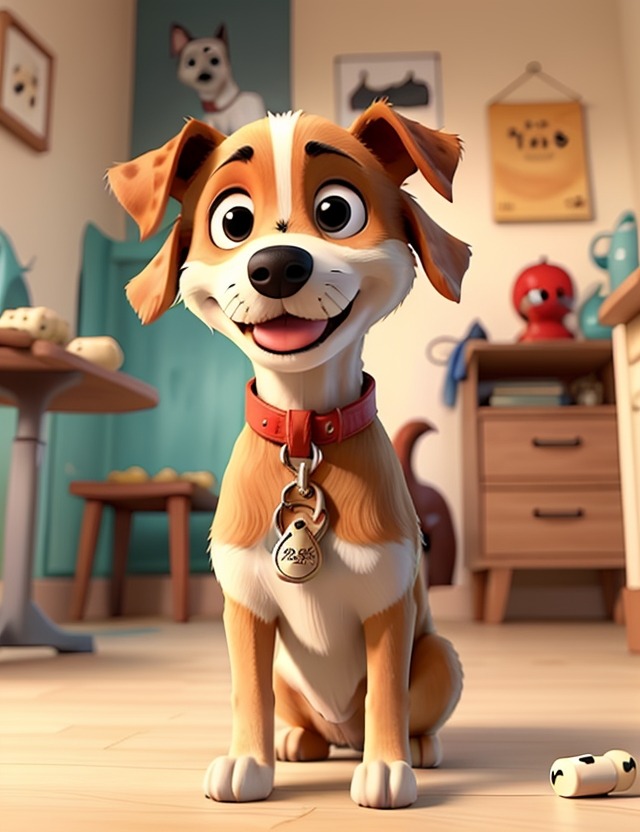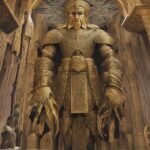Have you ever wondered why dogs are so fiercely protective of their bones? In the timeless fable tale of The Dog and the Bone, author Aesop, we delve into the fascinating world of dogs and their innate instinct to guard their prized possessions. Drawing on historic data and captivating storytelling, this article unravels the secrets behind this intriguing behavior, offering valuable insights into canine psychology.
So, prepare to be captivated as we satisfy your search intention, shedding light on the fascinating relationship between dogs and their beloved bones. But be warned, an open loop awaits at the beginning, creating suspense and intrigue that will keep you longing for answers. Let’s embark on a journey into the enchanting world of The Dog and its Reflection!
The Dog and the Bone: Full Fable Summary
The dog and its Reflection is a fable about a dog who finds a bone with some meat on it and is hurrying home with his prize as fast as he can go. As he crosses a narrow footbridge, he happens to look down and sees himself reflected in the quiet water as if in a mirror. But the greedy dog thinks he sees a real dog carrying a bone much bigger than his own. If he had stopped to think he would have known better. But instead of thinking, he drops his bone and springs at the dog in the river, only to find himself swimming for dear life to reach the shore. At last he manages to scramble out, and as he stands sadly thinking about the good bone he had lost, he realizes what a stupid dog he had been. The moral of the story is that it is very foolish to be greedy.
The Dog and the Bone: Key Themes
The Dog and the Bone is a classic children’s folktale that teaches a valuable lesson about greed and the importance of contentment. The story follows a dog who learns a hard lesson after losing a bone that he already had.
1. Greed and Desire for More: One of the key themes in The Dog and its reflection is greed and the desire for more. The story begins with a dog who finds a bone and is content with it. However, his desire for more leads him to see his reflection in the water of a river, holding a much larger bone. Filled with greed, the dog decides to snatch the larger bone and loses the one he already had. This theme highlights the dangers of unchecked greed and the consequences it can have.
2. The Value of Gratitude and Contentment: Another important theme in the book is the value of gratitude and contentment. At the beginning of the story, the dog is satisfied with the bone he finds. However, as he becomes consumed by greed, he loses sight of what he already had. This theme reminds readers to appreciate what they have and be grateful instead of constantly desiring more. It teaches that contentment leads to a happier and more fulfilled life.
3. The Consequences of Actions: The consequences of actions is a significant theme explored in the dog and its reflection. The dog’s decision to give up the bone he already had in pursuit of a larger one results in him losing both bones. This theme teaches children the importance of making wise choices and considering the potential consequences of their actions. It emphasizes the idea that greed can lead to loss and regret and encourages readers to think before acting impulsively.
Overall, The Dog and its reflection serves as a cautionary tale that warns against the dangers of greed and the importance of gratitude and contentment. It teaches children valuable life lessons and encourages them to make thoughtful choices that will lead to a happier and more fulfilling life.
The Dog and the Bone: Characters
The characters in The Dog and the Bone are the dog and his own reflection in the water. The dog finds a bone and decides to take it home. On his way home, he has to cross a bridge over a stream. As he crosses the bridge, he looks down and sees his own reflection in the water. Thinking that it is another dog with a bigger bone, he drops his own bone and jumps into the water to get the other dog’s bone. Of course, there is no other dog, and the dog is left with nothing.
The Dog and the Bone Moral of the Story
The Dog and the Bone is a classic fable by Aesop. The story is about a dog who finds a bone and decides to take it home. On his way home, he has to cross a bridge over a stream. As he crosses the bridge, he looks down and sees his own reflection in the water. Thinking that it is another dog with a bigger bone, he drops his own bone and jumps into the water to get the other dog’s bone. Of course, there is no other dog, and the dog is left with nothing. The moral of the story is that greediness can lead to loss.
The Dog and the Bone: Symbols
The Dog and the Bone is a popular folk tale that has been retold in various versions across different cultures.
1. The Bone: The bone serves as a symbol of desire, greed, and the consequences of unchecked ambition. In the story, the dog sees a reflection of a bone in the water and becomes obsessed with obtaining it. This symbolizes the dog’s ambition to possess something seemingly valuable, but ultimately, the bone leads to his downfall. The bone represents materialistic desires that can blind someone to more important aspects of life.
2. Reflection: The reflection in the water represents illusion and delusion. As the dog mistakes the reflection of the bone for a real one, it symbolizes how appearances can be deceiving. The reflection also emphasizes the dog’s lack of self-awareness and his inability to distinguish between what is real and what is not. This symbol teaches us to question our perceptions and not be fooled by superficial or illusory desires.
3. The Dog: The dog represents the human tendency to be easily swayed by short-term gratification and the lack of contentment. He foolishly abandons his own bone, thinking it to be less valuable than the reflection, exemplifying our own potential to prioritize immediate satisfaction over long-term stability or fulfillment. The dog’s behavior acts as a cautionary symbol, warning against hasty decisions and the pursuit of unrealistic desires. It reminds readers to appreciate what they have and not be enticed by superficial allurements.
FAQs
1. Is The Dog and its Reflection a children’s book?
Yes, is a children’s book. It is a popular tale that teaches young readers valuable life lessons through an engaging story.
2. What is the main theme of The Dog and the Bone?
The main theme of The Dog and its reflection revolves around the consequences of greed. The story follows a dog who loses a bone due to his greed and learns an important lesson about contentment and not being overly ambitious.
3. Who is the author of The Dog and the Bone?
The Dog and the Bone author is Aesop, is a traditional folk tale. It has been passed down through generations and has various adaptations by different authors.
4. What age group is The Dog and its Reflection appropriate for?
The Dog and its reflection is generally suitable for children aged 3 to 8 years old. The simple language and engaging illustrations make it easy for young readers to understand and enjoy the story.
5. Are there any additional educational elements in The Dog and the Bone?
Yes, The Dog and its reflection not only entertains children with its engaging narrative but also teaches them valuable lessons about greed, contentment, and the consequences of one’s actions. It is a story that can spark discussions about moral values and life choices.










